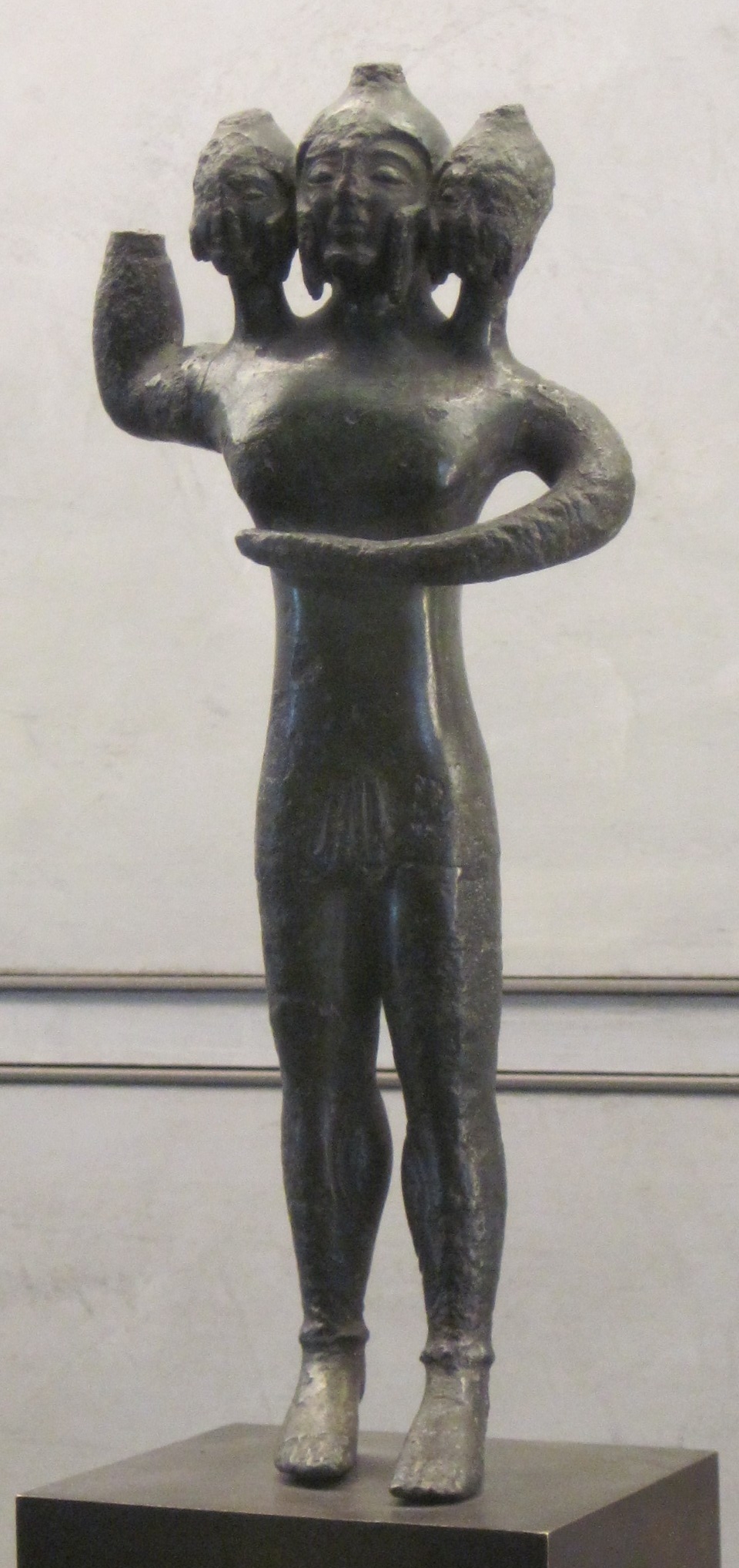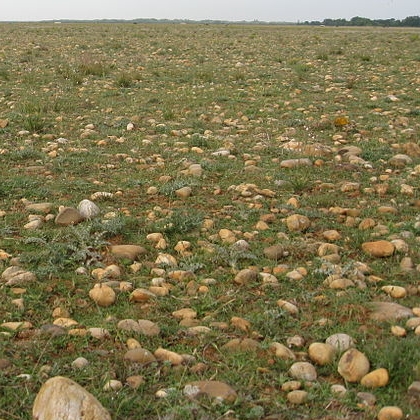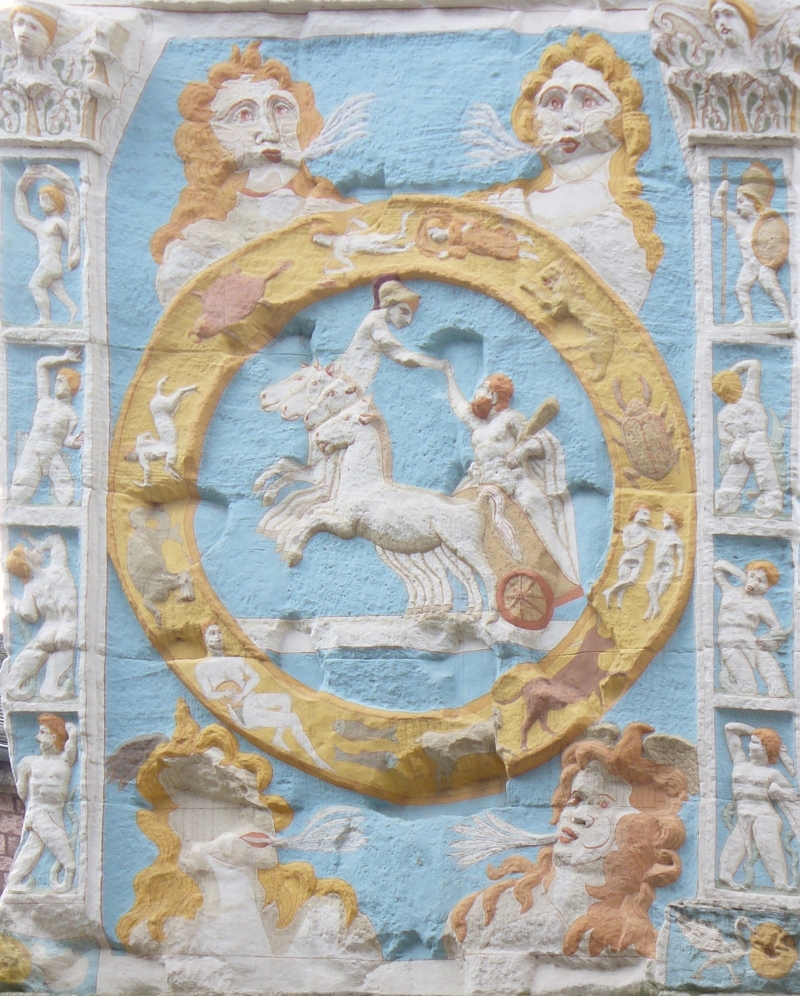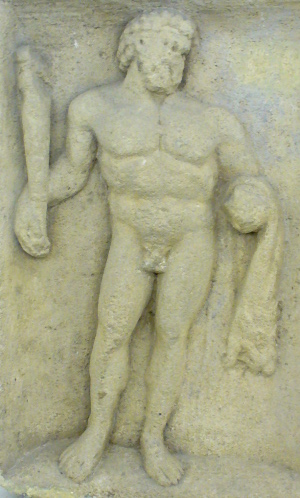HERCVLI SAXSANO: to HERCULES of the ROCKS
Ogmios · Smertrios · Saxsanus · Magusanus · Apotheosis
Hercules enjoys a perennial popularity. His superhuman strength, the fortitude and daring that he exhibits on so many occasions, the tragedy of his mortal life and his blessèd end as a god of Olympus—this whole mythology made him as irresistable in Antiquity as he still is in our day. He is a paragon of courageous and undaunted resistance ... and he triumphs.
The Gauls had particular reason for their attachment to this hero. They associated Hercules with numerous local stories, since he was said to have passed through Gaul during one of his Twelve Labours (the rustling of Geryon’s cattle). So it was that the cities of Autun, Alesia and Nîmes declared themselves to have been founded by HerculesDiodorus of Sicily, IV:19. and that the Lepontians boasted of their descent from his companions.Pliny the Elder, III:xxiv:20. During his stay, Hercules had affairs with many local princesses, whose children were (depending on the version of the story) Celtos, Galatos and/or Iberus, the eponymous ancestors of the Celts, Galatians and Iberians.Versions of this myth of ethnogenesis can be found in Parthenius of Nicæa, Timagenus of Alexandria and Dionysius of Halicarnassus. Hercules’ passage across Gaul thus linked these provinces to the Græco-Roman world starting from the earliest days of antiquity. Furthermore, the Gauls had to admire Hercules as the incarnation of that strength and spontaneous ardour so dear to the Celtic heart, if one can believe the ancient stereotype.
But these are not the only virtues attributed to the great hero. Lucian puts into the mouth of a learnèd Gaul the exegesis of an image of Ogmios, glossed as a Gaulish Hercules, as patron of eloquence. Beyond his physical force, Ogmios/Hercules was able to captivate people by the force of his words, and indeed, he is depicted with a number of chains flowing from his tongue to the heads of people who look not dismayed but pleased to be so bound to him. (Eloquence is also a value stereotypically much prized among the Celts.)
Inscriptions in Hercules’ honour are not particularly abundant in Gaul. Nonetheless, his image is frequently to be encountered, especially on the monumental Jupiter columns typical of the Rhenish region.
Apart from Ogmios, a frequent Herculean avatar in Gaul is Smertrios ‘provider’,Xavier Delamarre (2003), Dictionnaire de la langue gauloise, Éditions Errance, p. 276. whose name is known from the Pillar of the Boatmen of Paris (discovered in Notre-Dame cathedral).CIL XIII: 3026. Smertrios is depicted on this pillar as a bearded, (semi-?)nude man brandishing a club—the favoured weapon of Hercules—while bending forward to attack a serpent (a similar feat to defeating the Hydra?). Heroic nudity, the club, and the aggressive posture all bring Hercules to mind. Another inscription is dedicated [D]iti Smer[trio] Aug ‘to Dis Smertrius Augustus’ at Klagenfurt in Noricum (present-day Carinthia).Inscriptionum Lapidarium Latinarum Provinciae Norici usque ad annum MCMLXXXIV repertarum indices (ILLPRON) (1986), 121. This is of interest given that the druids taught that the Gauls were descended from Dis PaterC. Iulius Caesar (recapitulating Posidonius), De Bello gallico vi:18. (a Roman name for Pluto), a tradition worth comparing with the legends of Hercules as the founder of a number of Gaulish cities as we have mentioned.
The name Smertrius is evidently related to Smertulitanus ‘provider (far and) wide’.Cf. Xavier Delamarre (2003), Dictionnaire de la langue gauloise, Éditions Errance, pp. 203, 276. There was a priesthood at Chalons-en-Champagne in honour of the god Smertulitanus,AÉ (2004) 935. while the epithet Smertulitanus was attached to Mars in Möhn.CIL XIII: 4119. The Ancamna relief at Freckenfeld depicts Mars Smertrius with a club typical of Hercules. The ambiguity of this identification—now with Hercules, now with Mars—makes sense given their shared function as strong, active protectors.

Statuette of Geryon, whose defeat by Hercules had such weighty consequences for the Gauls.
(Etruscan, Musée des Beaux-Arts, Lyon)
In the Rhenish and Danubian regions, dedications are most often made to Hercules Saxanus (or Saxsanus, according to a typically Gaulish spelling mistake). This epithet is not of Celtic origin; it is to be understood as a normal Latin adjective—saxanus, belonging to stones, having to do with stones. As it happens, the myth that links Hercules to stones also anchors him in the soil of Gaul. According to S. Van Alpen, the epithet saxanus refers to an ambush suffered by Hercules while bringing back the cattle of Geryon. Returning from Spain by way of present-day Provence, Hercules found himself surrounded by enemy Ligurians. The hero prayed to his father Jupiter to come to his aid, and the latter caused rocks to rain down on the enemy. In this way, the rocky landscape of the Crau was formed.Pliny the Elder; Pomponius Mela, Chorographia II:5:78; Strabo, Geographia IV:i:7. In memory of this moment of piety and extraordinary aid, people might invoke Hercules Saxanus at times when, surrounded by enemies, they feared for their lives and only divine intervention might save them.S. Van Alpen (1826), Mémoires de la Société royale des antiquaires de France VII, pp. 53–58. Having become a god, Hecules is inclined to recall his own distress and aid in turn those who are suddenly in need of him.

Rocks as far as the eye can see: a landscape in the Crau.
(Modification of a photograph by Anevrisme, Creative Commons licence)
Be that as it may, it is known that inscriptions in honour of Hercules Saxsanus stretched from Germania InferiorNijmegen: H. Finke (1927), “Neue Inschriften”, Berichte der Römisch-Germanischen Kommission 17: 309. and Gallia BelgicaNorroy: Corpus Inscriptionum Latinarum [CIL] XIII: 4623–4625. Hermes: CIL XIII: 3475. as far as NoricumSmartno na Pohorju (Inscriptionum Lapidarium Latinarum Provinciae Norici [ILLProN]: 1892), Puch: ILLProN: 375–376. Koralpe: CIL III: 5093. Interestingly, the last of these invokes SSAXANO—the first S being perhaps an abbreviation for Silvanus rather than Hercules, or else a particularly exotic misspelling. and Venetia,Trento: CIL V: 5013. with a special concentration in Germania Superior. One site in particular accounts for the majority of attestations of the cult of Hercules Saxsanus: this is Brohl, near Treis-Karden, in the part of Treveran territoy that was broken off and annexed to the Germanies. The dedicants were legionaries from the army of Germania Inferior who were working the quarry of volcanic tuff there.Edith Mary Wightman (1970), Roman Trier and the Treveri, p. 192. For these, Hercules Saxsanus would have simultaneously represented physical strength (which was necessary for their work), protection (which was the purpose of these stones extracted from the quarry), and prowess in battle. He was thus the perfect patron god for Brohl’s military quarry-men. (It may be wondered whether a local tradition even identified Brohl as the site of Hercules’ battle, rather than the Crau ... But this is purely speculative.)
The Batavians were much devoted to Hercules Magusanus, whose Germanic or Celtic epithet has been variously interpreted: ‘old lad’, ‘hoary youth or eternal hero’, ‘strong’.See the Mantalon Bolgon’s page on *Magusenos/*Magôsenaz for a summary of these etymologies.
Attributes
Hercules’ depiction in Gaul is normally of the classical type. The god, muscled and bearded, is naked or nearly so. He carries a club, his preferred weapon. He often has the skin of the Nemæan lion on his back or draped over an arm. He may be carrying the apples of the Hesperides or fighting one of his numerous adversaries (such as Cerberus, the Hydra, or the lion).
Origins and Family
The father of Hercules is Jupiter; his mother was the mortal woman Alcmene (daughter of the king of Mycenæ and grand-daughter of Perseus). The myth has it that Juno and her protégé Eurysthenus unceasingly and pitilessly pursued this offspring of an adulterous liaison. Ruthless as it was, it was this adversity that inspired heroism and gave such legendary results. (John Scheid uses the term “civilizing work” for the acts of Hercules,The expression œuvre civilisatrice was used of Hercules by John Scheid during a lecture at the Collège de France. and with good reason. Hercules abolished human sacrifice among the Sabines; he founded cities and institutions; he freed Prometheus, the titanic benefactor of humankind; by overcoming monsters and tyrants, he cleared the way for a life of peace and good order.)
Hercules married Megara, daughter of Creon, and had two children by her; but during a fit of madness provoked by Juno, he strangled them. It was to expiate this crime that he was condemned to ten years of servitude to Eurysthenus, during which he accomplished the Twelve Labours. Afterwards, he took up with Omphale, who became his mistress in both senses of the term. The third and last wife of his mortal life was Deïanira, whose tragic love led to the hero’s death. Once established in Olympus, the god Hercules married Juventas (the goddess of youth, identified with the Greek Hebe).

Panneau de l’ascension d’Hercule sur la colonne d’Igel.
(Polychromatic replica, Rheinisches Landesmuseum Trier)
The Exaltation of the Soul
The first life of Hercules was that of a mortal hero. While his body died, the soul of Hercules was purified and elevated; from that moment on, he was even accepted in Olympus as a god in his own right. This is one of the plainest examples of apotheosis, the process by which a soul becomes a god. The Roman poet Ovid thus describes the apotheosis of Hercules:
“As a serpent, when it is revived from its old age, casts off the faded skin, and fresh with vigor glitters in new scales, so, when the hero had put off all dross, himself appeared celestial, majestic, and of godlike dignity. And him, the glorious father of the Gods in the great chariot drawn by four swift steeds, took up above the wide-encircling clouds, and set him there amid the glittering stars.”P. Ovidii Nasonis Metamorphoseon liber IX:266–272.
The number of gods is not closed, and many mortals over the years have posthumously joined their ranks. The most famous examples have been the Big Men of history (I use the gendered term advisedly, I’m afraid), like Romulus and Alexander, but this is partly because of the bias of our sources. Cicero was determined to divinize his prematurely deceased daughter Tullia—a remarkable person, but strictly a private individual. Another private individual, M. Lucceius Nepos, appeared in a dream to his kinsman, assuring him that he, Nepos, had become a god after his death.CIL VI: 21521. Translation and commentary in E. Courtney (1995), Musa Lapidaria, Scholars Press, pp. 170–173, 381–384. Not everybody is ready for apotheosis, but theoretically any soul may get there eventually.
Apotheosis had especially important implications for the imperial cult, a number of whose members were publically worshipped after their deaths as diui or diuae. At the same time, private persons were equally interested in prospects for apotheosis—at least if the testimony of the funerary monument of Igel is anything to go by.
A rich Treveran family, the Secundinii, who owed their prosperity to the cloth trade and rent on their lands, put up a column at Igel whose bad taste Camille Jullian deplored. Still, its panels reveal precious details in their scenes of domestic and commercial life. A single panel makes known the religious ideas of the family. At the centre, Hercules drives a chariot (that of the Sun?) up to the heavens, where a helmeted Minerva welcomes him. The whole is surrounded by signs of the Zodiac and allegorical representations of the four winds. On the left and right, a Mænad and an Amazon exult above six giants, who are enraged but powerless. According to Edith Wightman, Hercules symbolized the soul of the departed in its journey into eternity. The circle of the Zodiac represents the universe, cyclical and transcendent; it brings to mind the cosmic symbolism of the Mithraic cult. For the family of Secundinii, the world is a well-ordered whole, of which a virtuous soul might ascend to the eternal summits. Here, perhaps, is an echo of the Oriental mysteries,Wightman (op. cit.), p. 239. but it is Hercules who incarnates its promise—that god whose “civilizing work” had been universal and beneficent in scope.
Notes

En français svp !

Auf deutsch, bitte!

